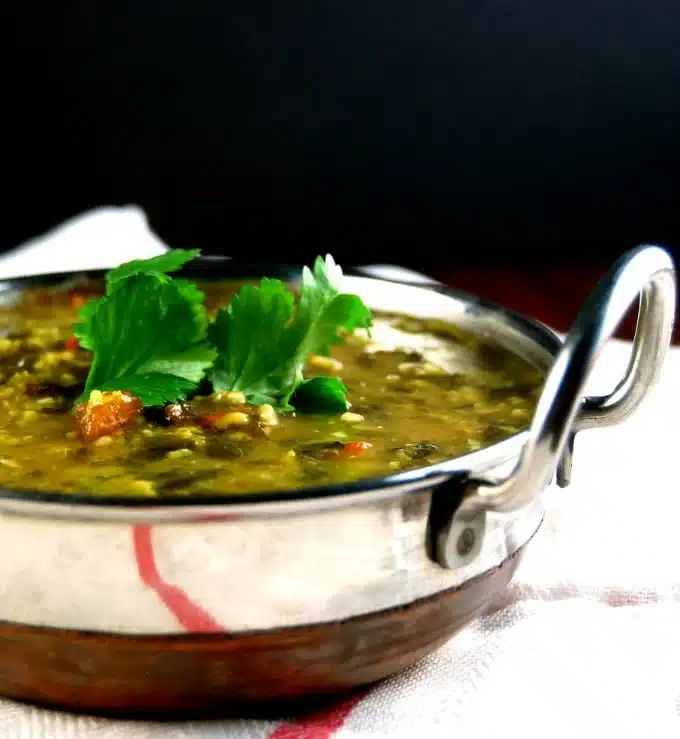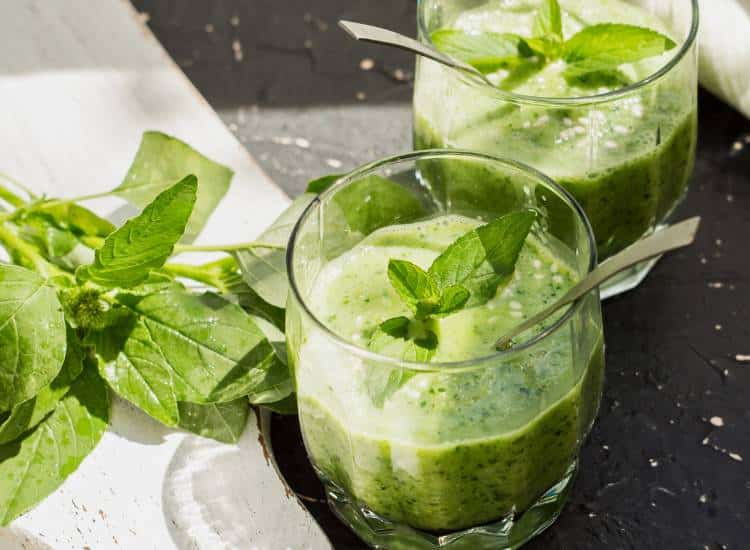Last Updated on February 28, 2024
Did you know that the leaves of cultivated and wild amaranth (aka pigweed, redroot pigweed, or red root amaranth) are not only edible but nutritious and tasty? Whether you find them growing in the garden or forage them from wild plants, amaranth greens are a prized vegetable around the world and can be used in all sorts of amaranth leaves recipes.
Get to know pigweed amaranth and enjoy a bounty of delicious greens great for cooking in amaranth leaves recipes all season long.

WHAT ARE AMARANTH GREENS? ARE AMARANTH LEAVES EDIBLE?
Amaranth greens are the leaves of cultivated or wild amaranth plant (amaranthus retroflexus), which is also known as redroot pigweed, pigweed amaranth, and many other combinations of these words. Both cultivated and wild amaranths are members of the amaranthaceae family. Edible amaranth greens can be harvested from a number of species of cultivated and wild amaranth plants.
Known as chaulai in Indian cooking, green and red amaranth leaves are both used in South American and African recipes as well as in the Jamaican dish called callaloo.
Pigweed amaranth is one of many common wild plants most of us don’t realize is not only edible, but delicious and nutritious as well. Along with purslane and wild spinach, pigweed amaranth is among the best greens you didn’t plant that you’re likely to find growing in your garden.
Many years ago I planted an amaranth called ‘Hopi Dye’ in my garden. I never needed to plant it again, as its hundreds of seeds planted themselves, and more than a decade later, I can harvest all the red amaranth leaves I could ever want. They’re far more abundant in my yard at this point than wild green amaranth.
Here’s one of my amaranth plant volunteers. I think amaranth’s red leaves are stunning, and it looks great in the garden bed or the wildflower patch.

The common redroot pigweed amaranth you’ll find growing wild is green, but it tastes very similar and can be used interchangeably with cultivated amaranth greens in the recipes for amaranth leaves below.

After so many years learning about and using the numerous edible wild plants growing in my tiny yard, I’ve amassed quite a collection of wild food recipes here on HealthyGreenSavvy. Be sure to check out our lambs quarters recipes, purslane recipes, garlic mustard recipes, and wild violet recipes as well!
WHAT PARTS OF THE AMARANTH PLANT ARE EDIBLE?
You can eat the leaves, stems, and seeds of both cultivated and wild amaranth plants. The leaves are most commonly used, but the stem can be treated as a separate vegetable as well. You should cook stems separately, as they’ll take longer to cook. More tender parts won’t need peeling, but older stalks might.
The seeds are of course sold as the grain amaranth, which you can serve as a hot cereal or like rice. It would make a great accompaniment for some of the amaranth leaves recipes below.
WHAT DO AMARANTH LEAVES TASTE LIKE?
Many foraging experts consider amaranth greens among the tastiest edible wild greens out there, particularly when cooked.
While not especially delicious to nibble right off the plant (like purslane or yellow wood sorrel, for example), sauteed and seasoned, green and red amaranth leaves are remarkably tasty. They hold up better than spinach and can be served as a side dish or added to numerous cooked dishes, like omelets and casseroles.
I would describe their flavor as a bit more prominent than spinach, but very pleasant-tasting and adaptable. And they hold up better to cooking than spinach in the recipes for amaranth leaves, maintaining their structure without being tough.
Anyone who’s tried to grow spinach in summer knows it’s a losing proposition. While spinach can’t take the heat, amaranth thrives and offers us abundant greens the entire growing season. And as much as I love lambs quarters, I find that amaranth greens have a less mineral-y flavor and work better in cooked recipes.
AMARANTH LEAVES BENEFITS & PIGWEED MEDICINAL USES
In addition to being a fantastic wild green to use in cooked recipes, amaranth leaves are sometimes also used medicinally.
Reputedly high in vitamin C and iron as well as many vitamins and minerals, amaranth leaves also contain fiber and antioxidants.
Native Americans used amaranth leaves as both food and medicine. They have astringent properties and have been used to help ulcers, diarrhea, and other digestive complaints as well as headaches, nausea, sore throats, and fevers.
CAUTIONS
Like so many other greens, amaranth leaves contain oxalates, which means they should be consumed in moderation, and those with kidney stones might do well to avoid them.
Amaranth can take up nitrates and heavy metals from the soil, so make sure you know what might be in the soil where you’re collecting your amaranth leaves.
FORAGING WILD AMARANTH LEAVES
Of course the first rule of foraging is to be absolutely sure you’ve correctly identified a plant using multiple features, as there are often poisonous look alikes.
Always consult a good field guide or go with an experienced forager to make certain your plant identification is correct. Here are some of the best foraging books to consider. Be sure to check out Sam Thayer’s incredible new foraging guide. It’s the most comprehensive foraging guide available and could be the only one you ever need if you live in eastern or central North America.
I highly recommend taking a local foraging class or checking out Herbal Academy’s online foraging course.

Note that since wild amaranth is often referred to as pigweed, the name could be confused with hogweed, a very different plant that you don’t want to eat or even touch. Here’s more about hogweed so you’re clear on the difference.
I’ll be adding a separate post on how to identify wild amaranth, but until then, I recommend reading this post from foraging expert Green Deane.
HOW TO USE CULTIVATED OR WILD AMARANTH LEAVES
Both green and red amaranth leaves are typically used cooked, though the youngest, most tender leaves may be consumed raw. Leaves will have the best flavor if picked before the plant sets seed.
Harvest leaves from the plant, but let the plant continue to grow.
Top uses for amaranth leaves:
♦ Green or red amaranth leaves may be sauteed and served as a side dish, or used like spinach in recipes like frittatas or casseroles. It would also work really well in a spinach dip.
♦ Often used as a potherb (a plant cooked in soups and stews), amaranth leaves can take the place of spinach in your favorite soup recipe.
♦ My favorite way to use mild wild greens like amaranth, lambs quarters, or Virginia waterleaf is to cook them in frittatas or add them to omelets. Amaranth greens are my favorite of the three for these uses.
♦ If your amaranth leaves are small and tender enough, you can try using them raw in salads or smoothies. They would work well in this anti-inflammatory smoothie recipe, or many of these healthy smoothie recipes.
If you’d like to preserve some amaranth leaves for use in winter, you can dehydrate, can, or freeze them as you would spinach. Here’s how to freeze spinach. You can use additional methods for preserving herbs to dry or freeze amaranth greens.
Amaranth leaves are a great choice to add to your homemade dried greens powder to add to pump up the nutrition of smoothies, soup, and pasta sauces. Here’s more on making your own greens powder.
Now on to the amaranth leaves recipes!
AMARANTH LEAVES RECIPES
Amaranth leaves are a staple in India, so you’ll find a number of Indian recipes using amaranth leaves below. From sauteed and spiced amaranth greens to dals studded with amaranth leaves, you’ll find a number of different ways to prepare these nutritious greens with Indian flavor.

AMARANTH LEAVES RECIPES: SIDE DISHES
A number of variations on sauteed amaranth leaves recipes featuring Indian spices to try:
♦ This Goan Red Amaranth Recipe from Dassana’s Veg Recipes calls for just a few simple ingredients, but sounds delicious!
♦ This Cheera Thoran recipe from Sinamon tales and this Stir Fried Amaranth Leaves recipe from Recipe Garden feature coconut and flavorful Indian spices
♦ This simple Chaulai-ka Saag from Whisk Affair makes amaranth leaves the star of the dish
♦ Garlicky Amaranth Leaves Curry from Healthy Indian includes both the greens and the stems of the amaranth plant
♦ This Chinese amaranth greens stir fry from Woks of Life is flavored with garlic and sesame oil
♦ One of the traditional uses for amaranth leaves is a Jamaican callaloo like this recipe from Healthier Steps

AMARANTH LEAVES RECIPES: MAINS
You can add some protein to your amaranth greens with dal, beans, or paneer, as in the amaranth leaves recipes below:

♦ This dal with amaranth greens from Holy Cow Vegan looks like a terrific dinner option, as does this dal recipes with amaranth leaves from Madhu’s Everyday Indian
♦ Tarladalal shares a rajma saagwala recipe with kidney beans and amaranth leaves
♦ Use your amaranth leaves in place of spinach in this saag paneer from Forager Chef
♦This Jamaican amaranth leaves stew from The Caribbean Pot has sweet potatoes and a medley of protein-rich beans
♦ These pigweed and purslane pizzas from Edible Wild Food use zucchini as their crust
AMARANTH LEAVES RECIPES: SOUPS, APPETIZERS, & MORE
♦ Blue Fufu makes a creamy amaranth leaves soup with coconut milk, sweet potatoes, and butternut squash
♦ Amaranth leaves are blended with red lentils in this masoor and chawli soup from Tarladalal
♦ These crispy amaranth leaves balls from Sailu’s Food are made with chickpea flour and would make a filling snack or appetizer
♦ Paratha stuffed with amaranth leaves would be perfect with one of the dal recipes
♦ A chutney made with amaranth leaves from Everyday Nourishing Foods would make a great accompaniment to many of these dishes!
♦ Young amaranth leaves can also be used instead of spinach in your favorite healthy smoothie recipe. Try this Tropical green smoothie from Simply Bakings

Don’t forget the stems can be prepared as a vegetable as well. Here’s an amaranth stem sukke recipe if you’re curious to try.
If you like these amaranth leaves recipes, check out these other delicious wild foods to explore throughout the season:
- Spruce Tips Recipes
- Serviceberry Recipes
- Mulberry Recipes
- Uses for Crab Apples
- Aronia Berry Recipes
- Hackberry Fruit
- Pine Needle Tea
Ever tried eating pigweed amaranth greens? What are your favorite recipes with amaranth leaves?
Save this info on edible amaranth greens and amaranth leaves recipes for later!

Additional amaranth leaves recipes cover photo credit: Esben_H

Susannah is a proud garden geek and energy nerd who loves healthy food and natural remedies. Her work has appeared in Mother Earth Living, Ensia, Northern Gardener, Sierra, and on numerous websites. Her first book, Everything Elderberry, released in September 2020 and has been a #1 new release in holistic medicine, naturopathy, herb gardening, and other categories. Find out more and grab your copy here.


 Hi, I'm Susannah, a garden geek, energy nerd, and fan of healthy food and natural remedies. Need some simple, practical solutions for living healthier and greener? You've come to the right place! More about me and my green projects
Hi, I'm Susannah, a garden geek, energy nerd, and fan of healthy food and natural remedies. Need some simple, practical solutions for living healthier and greener? You've come to the right place! More about me and my green projects
Leave a Reply